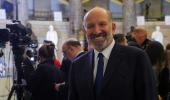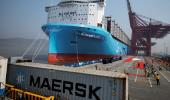Unless something changes, Mr Trump is a huge threat right now, which is perhaps not being recognised fully, cautions Debashis Basu.

Donald Trump was known to be unpredictable. But what he has unleashed since he became US president has shocked even hardened policymakers, businessmen, traders, investors, politicians, and bureaucrats.
And he has 46 months still to go.
After imposing punitive tariffs on Canada, Mexico and China, America's top trading partners, his next targets are the European Union, Japan, South Korea, Taiwan, and, of course, India.
Whatever one can understand of Mr Trump's policy -- from a recursive stream of consciousness -- is combative, simplistic, unstable, nativist, and improvised.
Any country that has a large trade surplus with America, he believes, is 'cheating us'.
They need to pay a big tariff to sell to the United States.
Coming next from Trumpland are reciprocal tariffs, which will match, item by item, the duties that American exporters face.
By one estimate, this would create 2.3 million individual levies. How serious are Mr Trump's antics, and how will they affect us?
The intellectual basis for Mr Trump's tantrums comes from Stephen Miran, now the chief of the Council of Economic Advisors.
In a paper written in November last year, Miran suggests the Trump regime aim for a weak dollar to boost exports, high tariffs to boost domestic manufacturing, and make other countries pay for holding US debt or even make them swap short-term debt for lower-yield 100-year bonds.
As Mr Trump takes a wrecking ball to global trade linkages, the impact will be devastating.
Economist Dani Rodrik, who specialises in globalisation, growth, and development, wrote: 'The world economy has achieved unprecedented levels of growth since World War II. Nothing in history comes even close -- not the Industrial Revolution and not the nineteenth-century era of globalization.'
The basis for this remarkable growth is surging global trade among Asia, the US, and Europe, and regional trade within Europe and the Americas, made possible by low transaction costs, including low tariffs.
As East Asian countries like Japan, Taiwan, South Korea, and Singapore started working hard to exploit their low-cost advantage, their exports to the developed world surged.
China joined this gang of exporting nations in the late 1990s and took it to a different level, becoming the workshop to the world, especially after it joined the World Trade Organization in 2001.
Next, exporters set up bases near their markets (China in Mexico to serve the US market) or simply to exploit lower costs (China in Vietnam or Thailand; South Korea and Japan in Malaysia).
Parallel to the surge in global trade, the post-war period also led to a rise in the US dollar as the global reserve currency.
Almost half the global trade is invoiced in dollars.
Since the bulk of the Asian exports went to the US, the trade surplus they generated was reinvested by Asian countries in US government bonds, allowing the US to continue issuing more debt and financing its imports from these countries without distorting the exchange rate.
Hence, when Mr Trump intends to uproot the current network of global trade linkages, the dollar will become extremely volatile, getting pushed upwards due to tariffs and downwards due to reduced growth from the same high tariffs, among myriad other push and pull factors.
A third factor adding to the volatility is the stunning brawl that Mr Trump has got into with every ally of the US.
The dollar's role as the world's reserve asset allowed America to project its strength, visible in its military bases across the world and invisibly through its ability to impose crippling financial sanctions on rogue regimes.
Mr Trump has chosen to rip off the security cover that the US provided to countries from Japan to Europe, while openly siding with Russia, part of an axis that includes China, North Korea, and Iran.
In other words, he intends to upend global trade, global investment, the dollar, and US security cover (which are all tightly interlocked), all at the same time.
The US is the most important market for India, as it is for many developing countries.
India's exports to the US make up 9 per cent of its exports, and as for merchandise exports they are 18 per cent.
Tied closely to Mr Trump's new trade policy is national security in all forms.
He wants to achieve self-sufficiency in several critical sectors, one of them being pharmaceuticals.
India exported pharmaceuticals of more than $10 billion to the US in 2023.
Finally, the country exported $50 billion of software services to the US in 2023.
Although the 'tech bros' that make up Mr Trump's team are supportive of the H1B visa, which allows Indian software engineers to work in the US, Mr Trump's core anti-immigrant supporters are not.
These are India's two of the biggest job-creating export sectors.
That aside, the best of Indian companies are exporters, mostly to the US.
They all will be under threat. Unless something changes, Mr Trump is a huge threat right now, which is perhaps not being recognised fully.
Debashis Basu is editor of moneylife.in and a trustee of the Moneylife Foundation
Feature Presentation: Aslam Hunani/Rediff.com












